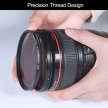Which Filter is Best for Photography?
If you are new to photography and thinking what's best for your photos that outshine others like a pro, well this is the right place for you. In this article, I will be discussing the different types of Camera Filters that you could use.

FILTERS HAVE DIFFERENT SIZES FIT FOR DIFFERENT CAMERA LENS

You just have to know the diameter of your camera.
Look on the inside of your Camera. Nine times out of ten the size of the lens cap is printed on the inside.
There are a lot of Camera Filters available on the market but these Camera Filters are said to be on the trend.
First to the list is this,
1. UV FILTER

Some of them will appear purple or purplish-red at certain angles due to the addition of anti-reflection film.
Benefits:
It helps to improve the clarity and color effect. However, due to the popularity of CMOS, the sensitivity of UV is greatly reduced, so now the main role of UV mirror is to protect the lens. But undeniably, the difference is clear in these photos.
2. Circlar Polarizing Filter (CPL Filter)

Composed of 2 polarizing mirrors. When using, rotate the front lens and rotate the front piece. Different angles have different effects on the measurement and saturation. Generally, it is used in the direction of 90 degrees from the light direction to maximize the effect. It generally reduces exposure by 2 levels and affects saturation.


Benefits:
CPL filter is used to eliminate the reflection of non-metallic objects. Notice how the water becomes clear on the photos when you use CPL filter.

3. (Neutral Density) ND Filter

What is ND Filter?
Also known as Neutral Density mirrors, these are circles and squares. The effect is to reduce the amount of light entering the camera. Especially in the slow door shooting water flow, traffic use is very wide.
Benefits:
It absorbs light and thus increases the exposure time so it allows you to achieve long exposures, especially in the middle of the day. If you want to take photos on a crowd where you want to be the focus and anyone else could not be seen in the photos, you could use ND Filter to blur people passing by. This speed also happens in this photo where water can be seen in motion.
The different types of ND Filters:
3.1 (Gradient ND mirror) GND Filter

a type of ND Filter that also lessen the light that enters the camera but instead of making the image darker, it only darkens a potion of the image. Imagine using a vignette effect on editing your photos.
Best for landscape shots.

3.2 Variable ND Filter

Advantage for moving photography, VND filters allows you to change light when you need to shoot fast. Unlike other ND filter, you don’t need to change it most of the time to adjust. Better for shooting videos.


In this video, advantages of Filters are being shown.
Out of all Filters that you know, what suits your taste best?
Happy shooting everyone! :D






Comments
There are no comments for this story
Be the first to respond and start the conversation.